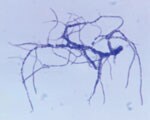Volume 28, Number 8—August 2022
Etymologia
Dermatophilus congolensis
From the Greek derma (skin) + philos (loving), Dermatophilus congolensis is a Gram-positive, aerobic actinomycete, and facultatively anaerobic bacteria (Figure 1). D. congolensis infects the epidermis and produces exudative dermatitis termed dermatophilosis that was previously known as rain rot, rain scald, streptotrichosis, and mycotic dermatitis.
In 1915, René Van Saceghem (Figure 2), a Belgian military veterinarian stationed at a veterinary laboratory in the former Belgian Congo (thus, the species name congolensis), reported D. congolensis from exudative dermatitis in cattle. Local breeders and veterinarians had observed the disease since 1910, but the causal agent was not identified.
Dermatophilosis affects animals, mainly cattle, and more rarely humans. Outbreaks of D. congolensis infection have severe economic implications in the livestock and leather industries.
References
- Amor A, Enríquez A, Corcuera MT, Toro C, Herrero D, Baquero M. Is infection by Dermatophilus congolensis underdiagnosed? J Clin Microbiol. 2011;49:449–51. DOIPubMedGoogle Scholar
- Branford I, Johnson S, Chapwanya A, Zayas S, Boyen F, Mielcarska MB, et al. Comprehensive molecular dissection of Dermatophilus congolensis genome and first observation of tet(z) tetracycline resistance. Int J Mol Sci. 2021;22:7128. DOIPubMedGoogle Scholar
- Dorland’s illustrated medical dictionary. 32nd ed. Philadelphia: Elsevier Saunders; 2012.
- Van Saceghem R. Contagious skin disease (contagious impetigo) [in French]. Bull Soc Pathol Exot. 1915;8:354–9.
Figures
Cite This ArticleOriginal Publication Date: July 11, 2022
Related Links
Table of Contents – Volume 28, Number 8—August 2022
| EID Search Options |
|---|
|
|
|
|
|
|

![René Van Saceghem (1884–1965). Source: Mortelmans J. Veterinary medicine in Belgian Congo and Ruanda-Urundi from 1885 to 1962 [in French]. Vlaams Diergeneeskundig Tijdschrift. 2003;72:83–95. Courtesy of the Institute of Tropical Medicine (Antwerp). https://vdt.ugent.be/?q=nl/content/72-2-83-95](/eid/images/21-2573-F2-tn.jpg)
Please use the form below to submit correspondence to the authors or contact them at the following address:
Rüdiger D. Ollhoff, Programa de Pós-Graduação em Ciência Animal, Pontifícia Universidade Católica do Paraná, Rua Imaculada Conceição, 1155 Prado Velho, Curitiba 80215 901, Paraná, Brazil
Top